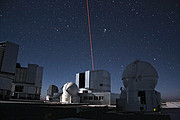Announcement
European Astronomy Journalism Prize Expanded
3 June 2013
The European Astronomy Journalism Prize 2013 is launched today and this year has been expanded to now include entries from Europe and South America. The competition is run by the Science and Technology Facilities Council (STFC) in the United Kingdom and ESO, in conjunction with the Association of British Science Writers and the Royal Astronomical Society.
"Astronomy is a global research discipline, and excites and inspires millions of people every day around the world, so we believe it's appropriate to expand the prize to recognise a broader range of inspirational coverage of astronomy," ESO's Head of Education and Public Outreach, Lars Lindberg Christensen, said today.
STFC Head of Communications Terry O'Connor said the inaugural competition in 2012 was open only to entries published or broadcast in English in the United Kingdom, but has now been extended to entries in English from any ESO Member State.
"We're delighted to work with ESO to offer the winner a trip to the world's most advanced optical instrument: ESO's Very Large Telescope in Chile," Terry said.
The VLT is located at the Paranal Observatory on Cerro Paranal, a 2635-metre mountain in the northern part of Chile.
Entries for the prize must be about astronomy and related areas of technology, or about the work and lifestyles of astronomers, engineers or others working in the field of astronomy.
The entries must reflect European interests and they can be online, written or broadcast.
Entries must have been published or broadcast during the period 1 July 2012 to 31 July 2013 inclusive. Applications close on Wednesday 31 July 2013.
Entry is open to journalists, students of a recognised journalism course, students of a recognised qualification in astronomy, or holders of a recognised qualification in astronomy, whose work is published or broadcast and is accessible to the general public. You may be asked to provide proof of your status.
Please make sure that you have read all the terms and conditions carefully. They are available online at www.stfc.ac.uk/astroprize and at www.eso.org/public/outreach/astroprize/
More information:
ESO
ESO is the foremost intergovernmental astronomy organisation in Europe and the world's most productive ground-based astronomical observatory by far. It is supported by 15 countries: Austria, Belgium, Brazil, Czechia, Denmark, France, Finland, Germany, Italy, the Netherlands, Portugal, Spain, Sweden, Switzerland and the United Kingdom. ESO carries out an ambitious programme focused on the design, construction and operation of powerful ground-based observing facilities enabling astronomers to make important scientific discoveries. ESO also plays a leading role in promoting and organising cooperation in astronomical research. ESO operates three unique world-class observing sites in Chile: La Silla, Paranal and Chajnantor. At Paranal, ESO operates the Very Large Telescope, the world's most advanced visible-light astronomical observatory and two survey telescopes. VISTA works in the infrared and is the world's largest survey telescope and the VLT Survey Telescope is the largest telescope designed to exclusively survey the skies in visible light. ESO is the European partner of a revolutionary astronomical telescope ALMA, the largest astronomical project in existence. ESO is currently planning the 39-metre European Extremely Large optical/near-infrared Telescope, the E-ELT, which will become "the world's biggest eye on the sky".
STFC
The Science and Technology Facilities Council is keeping the UK at the forefront of international science and tackling some of the most significant challenges facing society such as meeting our future energy needs, monitoring and understanding climate change, and global security.
The Council has a broad science portfolio and works with the academic and industrial communities to share its expertise in materials science, space and ground-based astronomy technologies, laser science, microelectronics, wafer scale manufacturing, particle and nuclear physics, alternative energy production, radio communications and radar.
STFC operates or hosts world class experimental facilities including: in the UK; ISIS pulsed neutron source, the Central Laser Facility, and LOFAR. STFC is also the majority shareholder in Diamond Light Source Ltd. overseas; telescopes on La Palma and Hawaii.
It enables UK researchers to access leading international science facilities by funding membership of international bodies including European Laboratory for Particle Physics (CERN), the Institut Laue Langevin (ILL), European Synchrotron Radiation Facility (ESRF) and the European Southern Observatory (ESO).
STFC also has an extensive public outreach and engagement programme. It is using its world leading research to inspire and enthuse schools and the general public about the impact and benefits that science can have on society.
STFC is one of seven publicly-funded research councils. It is an independent, non-departmental public body of the Department for Business, Innovation and Skills (BIS).
Follow us on Twitter @STFC_Matters
www.stfc.ac.uk
Royal Astronomical Society
The Royal Astronomical Society (RAS: www.ras.org.uk), founded in 1820, encourages and promotes the study of astronomy, solar-system science, geophysics and closely related branches of science. The RAS organises scientific meetings, publishes international research and review journals, recognizes outstanding achievements by the award of medals and prizes, maintains an extensive library, supports education through grants and outreach activities and represents UK astronomy nationally and internationally. Its more than 3500 members (Fellows), a third based overseas, include scientific researchers in universities, observatories and laboratories as well as historians of astronomy and others.
Association of British Science Writers
Links
- ESO's webpage about the competition
- The STFC competition webpage
- The Very Large Telescope
- STFC
- Royal Astronomical Society
- Association of British Science Writers
Contacts
Oana Sandu
The education and Public Outreach Department
ESO
Tel: +49 89 320 069 65
Email: osandu@partner.eso.org
Lucy Stone
Press Office
STFC Rutherford Appleton Laboratory
Tel: +44 (0)1235 445 627
Mob: +44 (0)7920 870125
Email: lucy.stone@stfc.ac.uk
Dr Robert Massey
Royal Astronomical Society
Mob: +44 (0)794 124 8035
Email: rm@ras.org.uk
Martin Ince
Association of British Science Writers
Email: martin@martinince.com
About the Announcement
| Id: | ann13050 |

